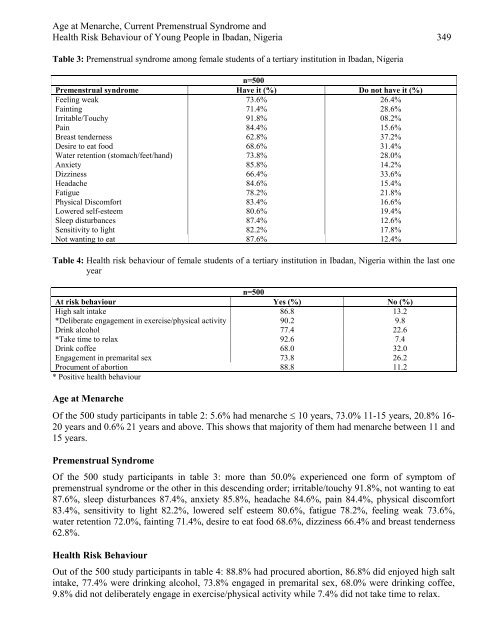European Journal of Scientific Research - EuroJournals
European Journal of Scientific Research - EuroJournals
European Journal of Scientific Research - EuroJournals
Create successful ePaper yourself
Turn your PDF publications into a flip-book with our unique Google optimized e-Paper software.
Age at Menarche, Current Premenstrual Syndrome and<br />
Health Risk Behaviour <strong>of</strong> Young People in Ibadan, Nigeria 349<br />
Table 3: Premenstrual syndrome among female students <strong>of</strong> a tertiary institution in Ibadan, Nigeria<br />
n=500<br />
Premenstrual syndrome Have it (%) Do not have it (%)<br />
Feeling weak 73.6% 26.4%<br />
Fainting 71.4% 28.6%<br />
Irritable/Touchy 91.8% 08.2%<br />
Pain 84.4% 15.6%<br />
Breast tenderness 62.8% 37.2%<br />
Desire to eat food 68.6% 31.4%<br />
Water retention (stomach/feet/hand) 73.8% 28.0%<br />
Anxiety 85.8% 14.2%<br />
Dizziness 66.4% 33.6%<br />
Headache 84.6% 15.4%<br />
Fatigue 78.2% 21.8%<br />
Physical Discomfort 83.4% 16.6%<br />
Lowered self-esteem 80.6% 19.4%<br />
Sleep disturbances 87.4% 12.6%<br />
Sensitivity to light 82.2% 17.8%<br />
Not wanting to eat 87.6% 12.4%<br />
Table 4: Health risk behaviour <strong>of</strong> female students <strong>of</strong> a tertiary institution in Ibadan, Nigeria within the last one<br />
year<br />
n=500<br />
At risk behaviour Yes (%) No (%)<br />
High salt intake 86.8 13.2<br />
*Deliberate engagement in exercise/physical activity 90.2 9.8<br />
Drink alcohol 77.4 22.6<br />
*Take time to relax 92.6 7.4<br />
Drink c<strong>of</strong>fee 68.0 32.0<br />
Engagement in premarital sex 73.8 26.2<br />
Procument <strong>of</strong> abortion 88.8 11.2<br />
* Positive health behaviour<br />
Age at Menarche<br />
Of the 500 study participants in table 2: 5.6% had menarche ≤ 10 years, 73.0% 11-15 years, 20.8% 16-<br />
20 years and 0.6% 21 years and above. This shows that majority <strong>of</strong> them had menarche between 11 and<br />
15 years.<br />
Premenstrual Syndrome<br />
Of the 500 study participants in table 3: more than 50.0% experienced one form <strong>of</strong> symptom <strong>of</strong><br />
premenstrual syndrome or the other in this descending order; irritable/touchy 91.8%, not wanting to eat<br />
87.6%, sleep disturbances 87.4%, anxiety 85.8%, headache 84.6%, pain 84.4%, physical discomfort<br />
83.4%, sensitivity to light 82.2%, lowered self esteem 80.6%, fatigue 78.2%, feeling weak 73.6%,<br />
water retention 72.0%, fainting 71.4%, desire to eat food 68.6%, dizziness 66.4% and breast tenderness<br />
62.8%.<br />
Health Risk Behaviour<br />
Out <strong>of</strong> the 500 study participants in table 4: 88.8% had procured abortion, 86.8% did enjoyed high salt<br />
intake, 77.4% were drinking alcohol, 73.8% engaged in premarital sex, 68.0% were drinking c<strong>of</strong>fee,<br />
9.8% did not deliberately engage in exercise/physical activity while 7.4% did not take time to relax.

















